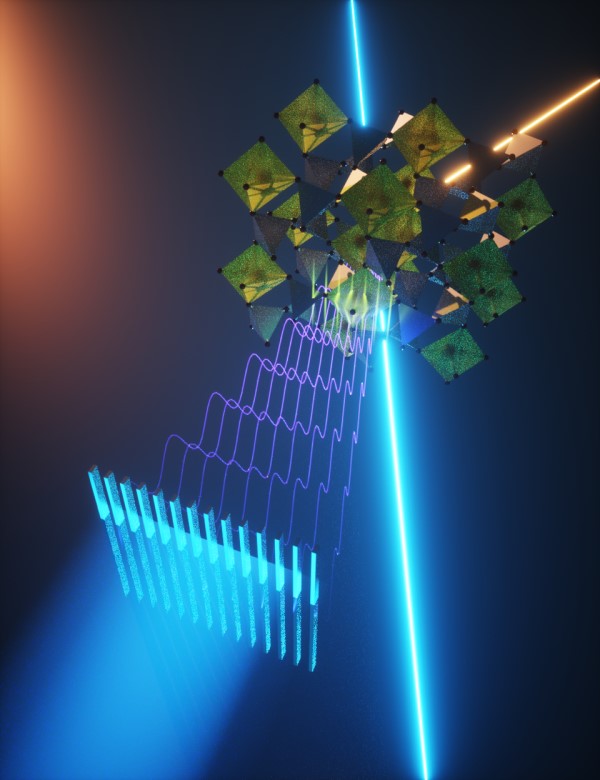Mezclando rayos X: el futuro de la ciencia ultrarrápida
20.04.2023
 |
|
Wave mixing methods in the X-rays. Imagen: Ella Marushchenko. |
- El Dr. Cristian Svetina ha logrado respuesta positiva a su propuesta a largo plazo para la instalación europea XFEL (EuXFEL).
- La propuesta es una de las 2 aceptadas por el EuXFEL en el periodo 2023-2025 e incluye tiempo de haz (beamtime) para realizar hasta 8 experimentos a lo largo de 3 años.
- El proyecto desarrollará las herramientas para comprender los fenómenos ultrarrápidos a nanoescala utilizando métodos de mezclado de ondas de rayos X.
| Tweet |
Madrid, 29 de septiembre, 2023. As the size of an object becomes smaller and smaller, the laws of classical physics break down and quantum physics rules the nanoworld. There, not only the intuitive notions of particle and waves are different, but even the concepts of locality and temperature fade away.
At such scales, charges, magnetism, orbitals and the lattice (atoms) couple generating an immense zoo of possibilities whose interplay is, in general, not understood. As microchips are shrinking in size, magnetic switches are getting faster, magnetic storage devices are improving in capacity and medical equipment for diagnostics and treatments are expanding, most of these technologies rely on devices taking advantage of such strongly coupled quantum nano-systems with immense benefit for medicine, tele-communication, computing, etc.
However there are still many fundamental unanswered questions that urge for understanding in order to push forward for the development of the next generation of green nano-technologies. A straightforward example that strongly affects everybody’s life is thermal management at the micro-nano scale: on large scales heat propagates in waves but at nanoscales is bounces like billiard balls on a table (the so called ballistic regime) and the prediction on how it will dissipate is not trivial. Being able to understand and control heat transport in semiconductors (like the silicon that is composing our cellphones, tablets and computer) at these scales would allow us to substantially reduce the energy losses of the electronic devices, thus alleviating the problem of heat dissipation and boosting the realization of more compact and efficient electronic elements with a major impact in technology and economy as well as in the environmental sustainability.
Now more than ever we need to address these questions: how can we design and build new and better energy-efficient functional nanomaterials with desired properties such as high-temperature superconductors, ultrafast magnetic switches, nano-thermal devices, photo-to-electro catalysis, ultrafast non-volatile memory storage, etc.? To answer these questions we must develop new experimental methods: in fact, current capabilities are limited in spatial-temporal resolutions and/or lack element selectivity and/or sensitivity, leaving these questions mostly unanswered still. To solve this problem, scientist at IMDEA Nanociencia are leading an international effort developing a class of novel methodologies called X-ray wave-mixing opening unprecedented opportunities.
Basically X-rays pulses (with high photon energy thus very short wavelengths), generated at X-ray Free Electron Lasers X-FELs (very long laser sources emitting intense pulsed X-rays) are mixed at a sample and, as a consequence, a new pulse is generated: the signal. Like in a good recipe, the outcome is much more than the sum of the single ingredients thus the signal carries all the information needed to understand how the material behaves. Extending this class of nonlinear experiments, routinely applied with optical lasers, in the X-ray domain would mean to be able to access to information on the transport processes, propagation of electrons between different atomic sites and the interplay of the degrees of freedom with sub-nanometer and ultrafast resolution with element and chemical specificity.
Imagine the impact these methods can provide in our understanding of physics in condensed systems (solids, liquids): we could shine light to the many pressing open questions regarding the nanoscale thermal transport, ultrafast demagnetization dynamics of ferromagnets, collective dynamics of disordered systems (glasses and liquids – for instance we still don’t know much about the fascinating properties of water and its many anomalies), charge transfer in light-harvesting systems, detection of chiral systems dynamics, dynamics of fluctuating charge density waves and quasi-particle in high temperature superconductors with consequences in the development of functional devices. Transport phenomena also play a central role in solution chemistry: at the macroscopic scale, they are governed by diffusion times in the micro- to millisecond range, but at the nanoscale, we enter the femto-to-picosecond domain, which may entail a ballistic behavior prior to a diffusive one. Accessing it with X-ray wave-mixing opens new perspectives onto solution chemical dynamics. Biophysics will also possibly benefit from the application of these methods to study side-chain dynamics in proteins, or charge/energy transfer in biosystems.
Truth is that application of these methods with the X-ray is so new, and still under development, that we don’t yet know how far they will bring us. What we know for sure is that the preliminary results we are obtaining are exciting and pointing in the right direction: we are developing the right tools to gain understanding of Nature at the nano and ultrafast scales like never before, and we are succeeding.
The group of Dr. Cristian Svetina at IMDEA Nanociencia will push forward the boundaries of knowledge at the X-ray science field with a new collaboration with the European XFEL (EuXFEL). The long-term project “Dynamics of nanoscale phenomena in solids and liquids studied with X-ray Transient Gratings at European” has been recently granted to Dr. Svetina (leader of the project) to perform up to 8 experiments at the EuXFEL facility over 3 years. Dr. Svetina will lead the project’s consortium, composed by 44 scientist from 7 countries: Italy, Germany, Switzerland, Sweden, Poland, United States and Spain in the leading role. The proposal of Svetina is one of the 2 accepted by the EuXFEL in the period 2023-2025..
Más información:
https://www.nanociencia.imdea.org/x-ray-wave-mixing-spectroscopies-x-waves/home
Contacto:
Dr. Cristian Svetina
X-ray Wave-mixing Spectroscopies (X-WaveS) Group
cristian.svetina @ imdea.org
Oficina de Divulgación y Comunicación de IMDEA Nanociencia
divulgacion.nanociencia [at]imdea.org
Twitter: @imdea_nano
Facebook: @imdeananociencia
Instagram: @imdeananociencia
Fuente: IMDEA Nanociencia.




